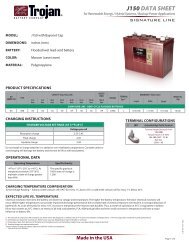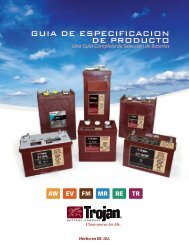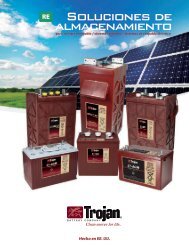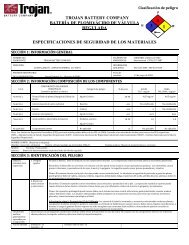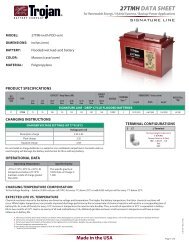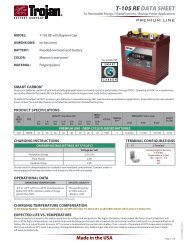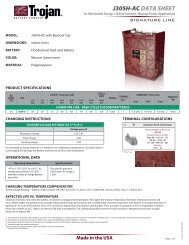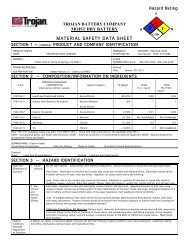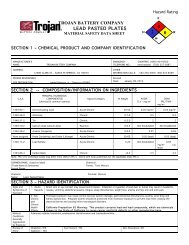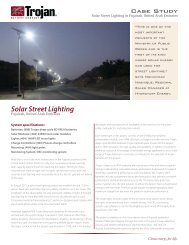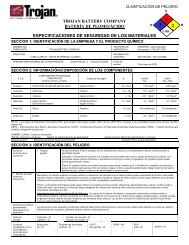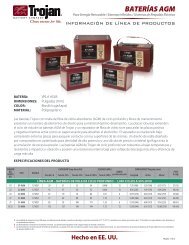PDF Page - Trojan Battery Company
PDF Page - Trojan Battery Company
PDF Page - Trojan Battery Company
You also want an ePaper? Increase the reach of your titles
YUMPU automatically turns print PDFs into web optimized ePapers that Google loves.
THE IMPORTANCE OF TESTING PV BATTERIES TO THE IEC 61427 STANDARDBased on the second equation shown above, if a battery delivers 15cycles to the IEC 61427 standard’s requirements, the battery has aservice life of 15 years in a PV application.THE IEC 61427 STANDARDThe IEC, recognizing that batteries in PV applications take on thecharacteristics of both float and cycling applications and are heavilycycled at PSOC at temperatures higher than 25°C (77°F), has developeda standard protocol that simulates a real-life PV application. The testsubjects the battery to a series of shallow DOD cycles under low andhigh SOC.The basic assumption is that the PV battery is charged during the dayand discharged during the night, with the typical discharge each dayconsuming between 2% and 20% of the battery’s amp-hour capacity.As shown in the Phase A and Phase B tables below, the IEC standardaccounts for the effects of seasonal cycling variability – winter cyclingwith low solar irradiation is simulated by cycling at low SOC (PhaseA), and summer cycling with high solar irradiation is simulated bycycling at high SOC (Phase B). This seasonal aspect of the cycling testincorporated in the IEC 61427 standard is another reason why testing aPV battery to this standard provides superior life expectancy estimates,than those offered in standard life cycle charts published by batterymanufacturers.In addition, the standard subjects the battery to PSOC cycles in whichthe batteries are discharged before they are fully charged – a verycommon occurrence in RE systems. This requirement significantlyreinforces the applicability of the IEC 61427 standard to batteries forPV systems.Combining the effects of seasonal (winter/summer) cycling and PSOCcycling to estimate the life of a battery in a PV application is far morerepresentative of the service a PV battery will be subjected to in anactual application. Therefore, when estimating a battery’s life in a PVapplication, <strong>Trojan</strong> strongly recommends that the IEC 61427 standardbe used as the primary benchmark. It is a much more reliable estimateof the battery’s life in a PV application than a manufacturer’s standardcycle life versus DOD chart.TEST REQUIREMENTS PER IEC 61427The IEC standard calls for 50 shallow cycles at a low SOC and 100 cyclesat a high SOC. The temperature of the test is maintained at 40°C (104°F).At the end of these 150 total cycles, the battery is load tested to check itscapacity – if it is at least 80% of its rated capacity the battery is subjectedto another sequence of 150 cycles. If not, the battery is considered tohave reached its end of life. The test protocol is summarized in the twotables to the right.CONCLUDING COMMENTSEstimating battery life expectancy in a PV application poses specialchallenges due to a variety of unknown factors, primarily related tointermittent weather conditions that impact both the charging anddischarging phases. Further complicating the issue, is the tendency tounderestimate the battery capacity required to power the loads.Since a typical PV application is mainly cyclic in nature and cannotbe correctly classified as either a float application or a true cyclingapplication, an alternate method is required to specify battery life in aPV application. The IEC 61427 standard provides that method. Becausethe conditions of the test simulate the following key characteristicsof a typical PV application, the IEC 61427 standard is particularly wellsuited to offer better insight into the life expectancy of a battery in aPV application.• Test temperature (40°C or 104°F) is warmer than normal roomtemperature and more representative of an actual PV batterysystem installation.• Seasonal (winter/summer) cycling accounts for variable chargingduring the year, which is true for PV applications.• Partial state of charge (PSOC) cycling allows for batteries to bedischarged before they are fully charged – a very commonoccurrence in PV applications.When a PV system designer is evaluating battery options for usein PV installations, the IEC 61427 standard should be used as thebenchmark to compare and contrast the batteries being consideredfor the application. This ensures an apples-to-apples comparison whichguarantees that each deep-cycle battery option is tested in exactly thesame way.More importantly, since the IEC standard subjects the battery to a setof operating conditions that more closely resemble what it will actuallyface in the real world, the results of the IEC test will provide the closestestimate of the battery’s service life in an actual PV application.Phase A: Shallow cycling at low SOC per IEC 61427Step Discharge time, hrs. Charge time, hrs. Current, A(a) 9 I 10(b) 3 1.03I 10(c) 3 I 10Repeat steps (b) and (c) 49 times, then proceed to Phase BPhase B: Shallow cycling at high SOC per IEC 61427Step Discharge time, hrs. Charge time, hrs. Current, A(a) 2 1.25I 10(b) 6Repeat steps (a) and (b) 99 timesI 10(Voltage limited to manufacturer’srecommendation)<strong>Trojan</strong> batteries are available worldwide through <strong>Trojan</strong>’s Master Distributor Network.We offer outstanding technical support, provided by full-time application engineers.For a <strong>Trojan</strong> Master Distributor near you,call 800.423.6569 or + 1.562.236.3000 or visit www.trojanbatteryRE.com© 2013 <strong>Trojan</strong> <strong>Battery</strong> <strong>Company</strong>. All rights reserved. <strong>Trojan</strong> <strong>Battery</strong> <strong>Company</strong> is not liable for damages that may result from any information provided in or omitted from thispublication, under any circumstances. <strong>Trojan</strong> <strong>Battery</strong> <strong>Company</strong> reserves the right to make adjustments to this publication at any time, without notices or obligation.RE_IEC61427Standard_1013



